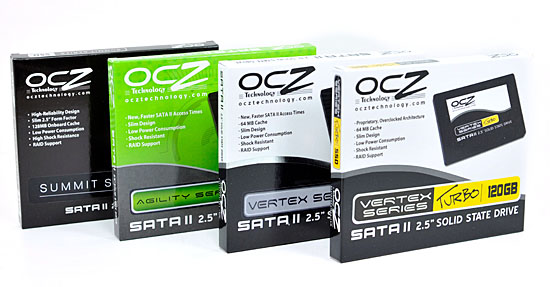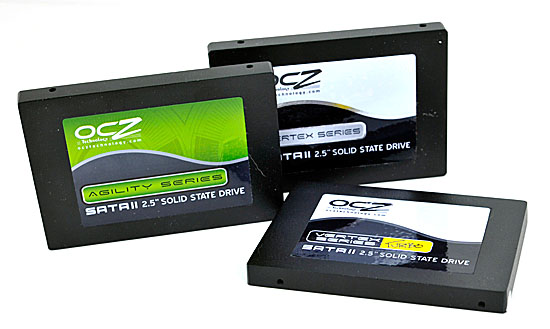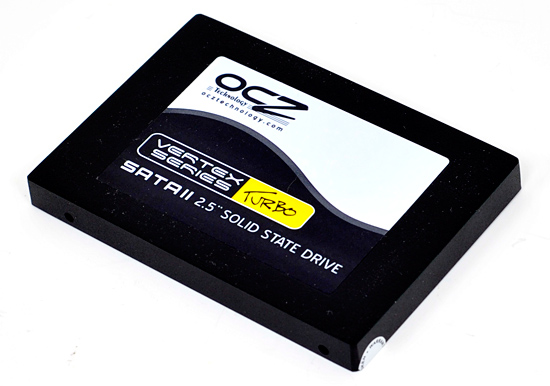The SSD Relapse: Understanding and Choosing the Best SSD
by Anand Lal Shimpi on August 30, 2009 12:00 AM EST- Posted in
- Storage
The OCZ Vertex Turbo: Overclocked Indilinx
I’ll have to give it to OCZ’s CEO Ryan Petersen, he always tries. The SSD race is once again heating up and he’s determined to compete on more than just price. OCZ’s entire Indilinx line of drives are going to be cheaper (at least in cost per GB) than Intel’s, but OCZ is also adding new drives to the lineup.

The Vertex and Agility we’re both familiar with. The Vertex EX is the SLC version and now we have the Vertex Turbo. The Turbo is a Vertex but with a faster controller and DRAM cache: 180MHz vs. 166MHz for the stock Vertex. It's not a physically different controller, it's just one that has been binned to run at 180MHz. OCZ helps Indilinx validate its drives and in exchange for that, Indilinx gives OCZ the exclusivity on 180MHz controllers.

We’re talking about an 8% increase in controller and DRAM frequency. If we’re lucky, we might reduce the time some instructions take to complete by a few nanoseconds. The problem is that we’re fundamentally bottlenecked by the performance of the NAND flash itself, which operates on the order of microseconds. In other words: don’t expect a performance boost.

We've already seen that these Indilinx drives can vary in performance by a few percent from drive to drive, so in order to make the comparison as accurate as possible I did all of my tests on the Vertex Turbo. After I was done running my Turbo tests I simply threw on the standard Vertex firmware, which specifies a 166MHz controller/DRAM clock.
| New Performance | OCZ Vertex | OCZ Vertex Turbo | Turbo Advantage |
| 4KB Random Write | 13.2 MB/s | 13.6 MB/s | 3% |
| 2MB Sequential Write | 175.9 MB/s | 184.2 MB/s | 4.7% |
As expected, there’s very little performance difference here. You'd see the same sorts of differences between two different Indilinx MLC drives. My Torqx sample from Patriot was as fast as my Vertex Turbo sample. OCZ charges a huge premium for the Turbo drive though:
| Price for 128GB | |
| OCZ Vertex | $369.00 |
| OCZ Vertex Turbo | $439.00 |
| Turbo Premium | 19% |
It's up to the price of a 160GB Intel X25-M G2, absolutely not worth it. I talked with Ryan Petersen, OCZ's CEO about the Turbo and its lack of value. As usual, we argued a bit but eventually gave me his vision. He wants to bring 180MHz controllers to all Vertex drives, and not charge premiums for it. His intentions are to improve how competitive OCZ's drives are in a sea of equal-performing Indilinx drives.
While I wouldn't recommend spending more money on the Turbo, if OCZ brings 180MHz controllers to all of its drives I won't complain.










295 Comments
View All Comments
jtleon - Tuesday, September 8, 2009 - link
Yes I fell asleep atleast 3 times reading this article (it IS Monday afterall)Yes, Indilinx clearly rocks the SSD world - Now I know thanks to Anand!
Stories like this set the standard for all review sites - I don't come away with the feeling I was just sold a bill of goods by some schiester in Intel's pocket, or otherwise.
Great Job Anand! Keep them coming!
SSDdaydreamer - Tuesday, September 8, 2009 - link
I too am wondering whether TRIM will be available on the Intel Drives for Windows XP or Vista. I seriously doubt it, as the OCZ Wiper Tool appears to only be available for Indilinx controllers. Perhaps Intel will introduce their own wiper utility. I am leaning towards the OCZ Vertex or Patriot Torqx drives, as I am quite content with Windows XP and Windows Vista.I have an itchy trigger finger on these SSDs, but I want to hold back for the following unknowns.
1. I would like to use the NTFS file system for my drive, but I am unsure of the proper/ideal block size.
2. I would merely like to image my existing Windows Installation, but I am worried that performance or stability problems will arise from the NTFS file system. A fresh install could be in order, but it is preferred to image.
3. Is there a way to change the size of the spare area? Maybe I have the wrong idea (perhaps only format part of the drive, unformatted space goes appends to the spare area?) I am willing to sacrifice some of the usable partition space for an increased spare area for improved performance.
4. Are there complications with multiple partitions? If there are multiple partitions on the drive (for multi-boot) do they all share the same spare area? Is it possible to allow their own respective spare areas?
Is there anybody out there that could enlighten me? I'm sure others would do well to have the answers as well. If I make any discoveries, I will be sure to post them.
Thanks in advance.
bradhs - Monday, September 7, 2009 - link
IS there a "Wiper" app for Intel X-25m G2 drives? For people who don't have Windows 7 (TRIM) and want to keep the Intel X-25m G2 running smooth.smjohns - Tuesday, September 8, 2009 - link
No there is no wiper tool for Intel drives at the mo. In addition to this the current firmware on the Intel drives do not have TRIM enabled. I guess this will be released soon after Windows7 is released. I think I have read somewhere that Intel are working on a TRIM version of it's Matrix Storage Manager software that will provide this functionality to the other operating systems.Burny - Monday, September 7, 2009 - link
As many before me: great article! I learned a lot about SSD's. Even up to the point i'm ready to buy one.I still have 2 questions tough:
2. Will TRIM be available on the G2 Intel drives for sure? Some sources doubt this: http://www.microsoft.com/communities/newsgroups/en...">http://www.microsoft.com/communities/ne...t=&l...
3. As I understand, TRIM will work on a firmware level. That implies that TRIM will also function under Windows XP or any OS for that matter? Then why the need to build another TRIM into Windows 7? Or does a TRIM firmware enabled SSD simply allows the OS to use TRIM?
Thanks!
smegforbrain - Monday, September 7, 2009 - link
While I consider myself handy with computers, I'm not the best technical mind when it comes to the details. You do an excellent job of presenting everything in a manner that it can be understood with little difficulty. I look forward to future articles about SSDs.I do have a question I'm hoping somebody can answer. I'm as interested in the long-term storage outlook of SSD drives as I am every day use. I've seen it said that an SSD drive should hold its charge for 10 years if not used, and it was discussed a bit earlier in this thread.
Yet, none of my current mechanical hard drives are more than 3 years old; none of my burned DVDs/CDs are older than 5 years. It seems far more likely that I would replace an SSD for one with a greater storage capacity after 5 years tops than to expect one to be in use, even as archival storage, for as long as 10 years.
So, is the 10 year 'lifespan' even going to be an issue with archival storage for most people?
Will this worry over the life span of an SSD become even less of an issue as the technology matures over the next couple of years?
Starcub - Tuesday, September 8, 2009 - link
"So, is the 10 year 'lifespan' even going to be an issue with archival storage for most people?"No, but who takes wads of money out of their wallet to store it on their shelf?
smegforbrain - Tuesday, September 8, 2009 - link
"No, but who takes wads of money out of their wallet to store it on their shelf?"That is simply assuming that they will remain as expensive as they are now. They won't.
BlackSphinx - Sunday, September 6, 2009 - link
Hello! I'm taking the time to comment on this article, because I am very thankful for all of these awesome write-ups on SSD.I'm in the process of building an heavily overclocked i7 rig for gaming and video edition, and I was going to jam 2 Velociraptors in Raid0 in there. Why? I had only heard bad things about SSDs in the past.
Reading your aticles, who are, while in depth, very clear and easy to understand, I understand much better what happened in early SSDs, what's so good about recent Indilinx and Intel SSD, and, truly, why I should forgo mechanical drives and instead go the SSD route (which, frankly, isn't more costly than a Raid0 raptor setup). In short, these articles are a great service to the end users just like myself, and if they were intended as such, you have passed with flying colors. Congratulations and thanks.
Transisto - Sunday, September 6, 2009 - link
Could someone reset my brain as to why there is no way to get a (very noticeable) improvement from USB thumb-drives. I mean these thing also get 0.1 ms latency.It's a bit extreme but for the same price I could get 9 cheap 8gb SLC usb drive for around 20$ each and put them in three separate PCI-USB add-on card (5$)
They would saturate the USB controler with 3 drive in it so I Could get around 140mb/s read and 60mb/s write.
Say you manage to merge that into a raid or ... ? Is eboost or Readyboost any good at scaling up ?